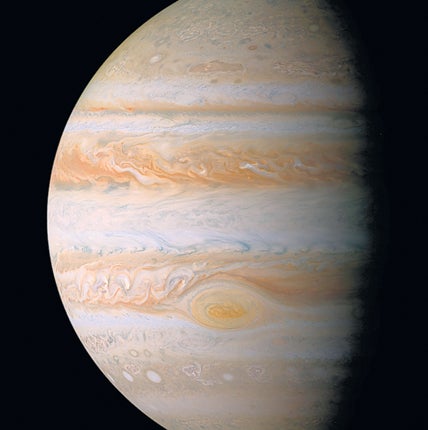Up telescope! Search begins for giant new planet
Tyche may be bigger than Jupiter and orbit at the outer edge of the solar system

Your support helps us to tell the story
From reproductive rights to climate change to Big Tech, The Independent is on the ground when the story is developing. Whether it's investigating the financials of Elon Musk's pro-Trump PAC or producing our latest documentary, 'The A Word', which shines a light on the American women fighting for reproductive rights, we know how important it is to parse out the facts from the messaging.
At such a critical moment in US history, we need reporters on the ground. Your donation allows us to keep sending journalists to speak to both sides of the story.
The Independent is trusted by Americans across the entire political spectrum. And unlike many other quality news outlets, we choose not to lock Americans out of our reporting and analysis with paywalls. We believe quality journalism should be available to everyone, paid for by those who can afford it.
Your support makes all the difference.If you grew up thinking there were nine planets and were shocked when Pluto was demoted five years ago, get ready for another surprise. There may be nine after all, and Jupiter may not be the largest.
The hunt is on for a gas giant up to four times the mass of Jupiter thought to be lurking in the outer Oort Cloud, the most remote region of the solar system. The orbit of Tyche (pronounced ty-kee), would be 15,000 times farther from the Sun than the Earth's, and 375 times farther than Pluto's, which is why it hasn't been seen so far.
But scientists now believe the proof of its existence has already been gathered by a Nasa space telescope, Wise, and is just waiting to be analysed.
The first tranche of data is to be released in April, and astrophysicists John Matese and Daniel Whitmire from the University of Louisiana at Lafayette think it will reveal Tyche within two years. "If it does, John and I will be doing cartwheels," Professor Whitmire said. "And that's not easy at our age."
Once Tyche has been located, other telescopes could be pointed at it to confirm the discovery.
Whether it would become the new ninth planet would be decided by the International Astronomical Union (IAU). The main argument against is that Tyche probably formed around another star and was later captured by the Sun's gravitational field. The IAU may choose to create a whole new category for Tyche, Professor Matese said.
The IAU would also have the final say about the gas giant's name. To the Greeks, Tyche was the goddess responsible for the destiny of cities. Her name was provisionally chosen in reference to an earlier hypothesis, now largely abandoned, that the Sun might be part of a binary star system with a dim companion, tentatively called Nemesis, that was thought responsible for mass extinctions on Earth. In myth, Tyche was the good sister of Nemesis.
Tyche will almost certainly be made up mostly of hydrogen and helium and will probably have an atmosphere much like Jupiter's, with colourful spots and bands and clouds, Professor Whitmire said. "You'd also expect it to have moons. All the outer planets have them," he added.
What will make it stand out in the Wise data is its temperature, predicted to be around -73C, four or five times warmer than Pluto. "The heat is left over from its formation," Professor Whitmire said. "It takes an object this size a long time to cool off."
Most of the billions of objects in the Oort Cloud – a sphere one light year in radius stretching a quarter of the distance to Alpha Centauri, the brightest star in the southern constellation – are lumps of dirty ice at temperatures much closer to absolute zero (-273C).
A few of these are dislodged from their orbits by the galactic tide – the combined gravitational pull from the billions of stars towards the centre of the Milky Way – and start the long fall into the inner solar system.
As these long-period comets get closer to the Sun, some of the ice boils off, forming the characteristic tails that make them visible.
Professors Matese and Whitmire first proposed the existence of Tyche to explain why many of these long-period comets were coming from the wrong direction. In their latest paper, published in the February issue of Icarus, the international journal of solar system studies, they report that more than 20 per cent too many of the long-period comets observed since 1898 arrive from a band circling the sky at a higher angle than predicted by the galactic-tide theory.
No other proposal has been put forward to explain this anomaly since it was first suggested 12 years ago. But the Tyche hypothesis does have one flaw. Conventional theory holds that the gas giant should also dislodge comets from the inner Oort Cloud, but these have not been observed.
Professor Matese suggests this may be because these comets have already been tugged out of their orbits and, after several passes through the inner solar system, have faded to the point that they are much harder to detect.
So if it is real, Tyche may not only be disrupting the orbits of comets, it may also overturn an established scientific theory.
You can download a PDF showing the position of Tyche by clicking here
Subscribe to Independent Premium to bookmark this article
Want to bookmark your favourite articles and stories to read or reference later? Start your Independent Premium subscription today.
Join our commenting forum
Join thought-provoking conversations, follow other Independent readers and see their replies
Comments